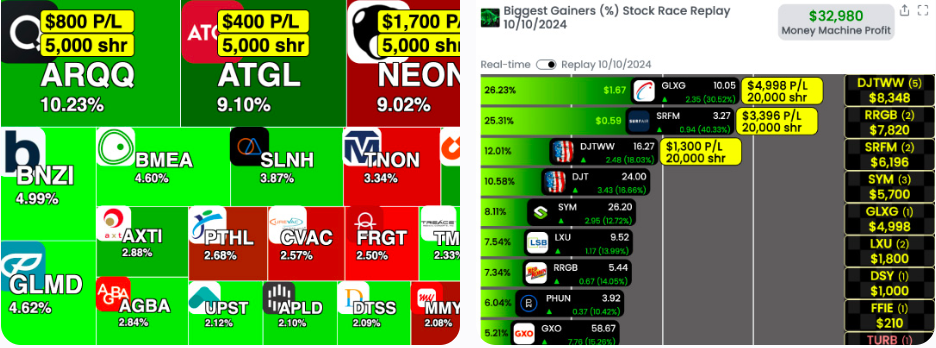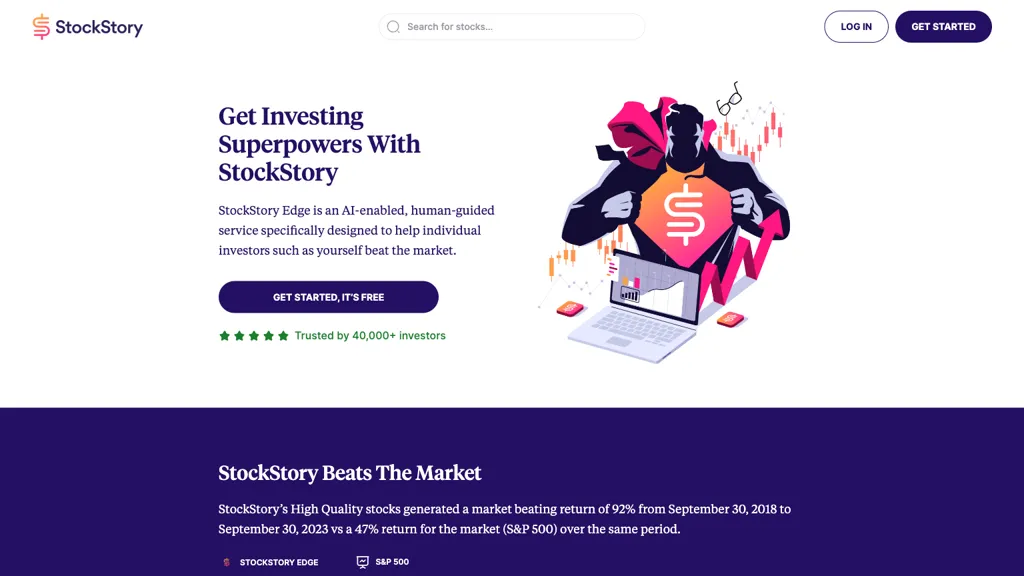20 New News On Choosing AI Stock Investing Analysis Websites
20 New News On Choosing AI Stock Investing Analysis Websites
Blog Article
Top 10 Tips On Assessing The Data Sources And The Quality Of Ai Stock Predicting/Analyzing Trading Platforms
To ensure accurate and reliable information, it is crucial to examine the quality of data sources and AI-driven stock trading platforms. Insufficient data could lead to incorrect predictions, loss of money, and a lack of trust. Here are the top 10 ways to assess sources and data quality:
1. Verify the data sources
Verify the source of the data. Ensure that the platform uses well-known, reputable sources of data (e.g. Bloomberg Reuters Morningstar, or stock exchanges such NYSE, NASDAQ).
Transparency: The platform should openly disclose the data sources it uses and keep them updated regularly.
Beware of dependency on a single source: Trustworthy platforms usually aggregate data from multiple sources to reduce error and bias.
2. Examine the freshness of data
Data that is delayed and real-time: Determine if a platform provides real time data or delayed. Real-time data is crucial for trading that is active. Delay data is sufficient for long-term analyses.
Be sure to check the frequency of updates (e.g. minute-by-minute updates or hourly updates, daily updates).
Accuracy of historical data Verify that the data is consistent and free of anomalies or gaps.
3. Evaluate Data Completeness
Check for missing data: Check for missing tickers or financial statements as well gaps in the historical data.
Coverage: Make sure that the trading platform supports an extensive range of stocks and indices relevant to your plan.
Corporate actions: Make sure your platform can be able to account for splits in stock or dividends. Also, check if it accounts for mergers.
4. Accuracy of Test Data
Cross-verify your data: Check the data on your platform against other trustworthy sources.
Error detection: Watch out for incorrect pricing, mismatched financial metrics or other outliers.
Backtesting: You can utilize historical data to test trading strategies. Check if they match your expectations.
5. Examine the data's Granularity
The level of detail: Make sure that the platform can provide detailed data, such prices for intraday quantity bidding-asking spreads, and depth of the order book.
Financial metrics: Ensure that the platform is able to provide comprehensive financial statements like income statement, balance sheet and cash flow. Also, check if it includes key ratios like P/E (P/B), ROE (return on equity) and more. ).
6. Verify that the Data is Clean and Preprocessing
Normalization of data: Ensure that the platform normalizes the data (e.g. making adjustments for dividends, splits) to ensure that the data remains consistent.
Outlier handling: Check how the platform handles outliers or anomalies within the data.
Missing estimation of data: Ensure that the platform is based on reliable methods for filling the gaps in data.
7. Examine Data Consistency
Align all data with the same timezone. This will avoid discrepancies.
Format consistency: Verify that the data has been presented consistently (e.g. currency, units).
Cross-market consistency: Verify data alignment across markets or exchanges.
8. Relevance of Data
Relevance to trading strategy: The data should be aligned with your style of trading (e.g., technical analysis or quantitative modeling, fundamental analysis).
Selecting features : Make sure the platform includes features that are relevant and can help you make better predictions.
Check the integrity and security of your data
Data encryption: Make sure the platform is using encryption for data transmission and storage.
Tamper proofing: Make sure that the information on the platform isn't being altered.
Compliance: Verify that the platform is compatible with all applicable laws regarding data protection (e.g. GDPR or the CCPA).
10. Transparency in the AI Model of the Platform is evaluated
Explainability. You must be aware of how the AI makes use of data to make predictions.
Bias detection: Check whether the platform is actively monitoring and corrects biases in the models or data.
Performance metrics - Examine the track record of the platform and performance metrics (e.g. accuracy, recall and precision) to assess the accuracy of their predictions.
Bonus Tips
User feedback and reputation Review reviews of users and feedback to assess the platform's reliability.
Trial period: Take advantage of the trial period for free or demo to check the quality of data and features prior to committing.
Support for customers: Make sure that the platform provides a dependable customer service that can assist with questions about data.
Following these tips will enable you to analyze the data quality, source, and accuracy of stock prediction systems based on AI. Read the most popular sell about best ai trading app for blog recommendations including options ai, ai stocks, ai investing platform, ai for trading, ai stock market, ai investing app, market ai, trading with ai, ai stock trading, best ai stock and more.
Top 10 Tips For Evaluating The Regulatory Compliance Of Ai Stock Prediction/Analyzing Trading Platforms
The regulatory compliance is a crucial element when it comes to looking at AI trading platforms for stock prediction or analysis. Compliance is crucial since it ensures that the platform is in compliance with regulations and legal frameworks. It also protects the users' personal information. Here are 10 top tips on how to assess the level of compliance these platforms have.
1. Check the Licensing and Registration
Regulators: Check that the platform is registered and licensed with relevant financial regulatory authorities (e.g. SEC in U.S.A., FCA UK, ASIC Australia).
Broker partnerships: If a platform integrates with brokers, ensure that the brokers are properly licensed and regulated.
Public records: Visit the regulator's website to verify the status of registration as well as previous violations.
2. Measure Data Privacy Compliance
GDPR: If you are operating or providing services to users in the EU Make sure your platform is in compliance to the General Data Protection Regulation.
CCPA : California Consumer Privacy Act (CCPA) compliance must be checked by users.
Data handling policies: Check the data privacy policy of the platform to determine what it says about data collection, storage, and sharing.
3. Evaluate Anti-Money Laundering (AML) measures
AML policies: Ensure the platform has robust AML policies to stop and identify the laundering of money.
KYC procedures: Find out whether the platform supports Know Your Customer (KYC) which validates user identities.
Transaction monitoring: Check if the platform monitors transactions for suspicious activity and reports it to relevant authorities.
4. Make sure that you are in compliance with Trading Regulations
Market manipulation: Make sure that the platform has measures to prevent market manipulation, such as spoofing, wash trading.
Types of orders: Make sure that the platform is in compliance with the regulations applicable to different types of orders (e.g. there is no stop-loss hunt).
Best execution: Make sure to see if the website follows the best execution practices, which ensures that trades are executed at the lowest possible cost.
5. Cybersecurity Assessment
Data encryption: Ensure that the platform safeguards your data during transport and at rest, using encryption.
Incident response - Verify the system's plans to react in the event of cyberattacks or data breaches.
Certifications - See if your platform has any cybersecurity certifications.
6. Transparency and Disclosure A Review
Fee disclosure - Make sure all fees are made public, including additional or hidden charges.
Risk disclosure: Check if there is a clear declaration of risks, specifically for high-risk or leveraged trading strategies.
Performance reporting: Determine if the platform provides precise and transparent performance reports for its AI models.
7. Make sure you're in compliance with International Regulations
Trading across borders: If you are trading internationally, ensure that the platform you use is in compliance with all applicable regulations.
Tax reporting - Check whether a platform offers tools and reports to assist users in complying with tax laws.
Conformity with sanctions: Ensure that the platform adheres and does NOT allow trading or dealings with banned countries or entities.
8. Examine Audit Trails and Record-Keeping
Transaction records: Make sure the platform keeps accurate records of all transactions to ensure audit and regulatory compliance.
Logs of user activity - Check that the platform logs every user's activity including logins to the platform, trades that are made and any modifications to the account settings.
Audit readiness: Verify that the platform is able to supply all the necessary documents and logs in the event of the need for a regulatory audit arises.
9. Verify compliance with AI-specific Regulations
Algorithmic rules of trading: If the platform permits algorithmic trading, it should comply with European regulations like MiFID II and U.S. Reg SCI.
Fairness and impartiality: Check whether the platform's AI models are monitored and tempered to ensure that they are not biased.
Explainability - Make sure that the system can give clear and concise explanations regarding AI-driven predictions, decision-making and more. in accordance with certain regulations.
Examine the User Feedback and the Regulatory Histories
User reviews: Study reviews from users to assess the platform's reputation for regulatory compliance.
The history of regulation: Check for past violations of the regulations, fines or penalties.
Third-party Audits: Verify that the platform undergoes third-party reviews to ensure the platform is in compliance with all applicable regulations.
Bonus Tips
Legal consultation: Consult with an expert in law on the compliance of the platform with relevant rules.
Free trial period: You are able to make use of a demo or a no-cost trial to evaluate the features that ensure compliance of the platform as well as its documentation.
Support for customers: Ensure that the platform offers support in case of questions or problems related to compliance.
These tips will help you assess the regulatory compliance for AI stock-predicting/analyzing trading platform. You can pick a system that is in compliance with legal frameworks while protecting your security. Compliance does not just help reduce legal risks, but also increases trust with the platform. Check out the most popular ai for trading stocks for site examples including chart ai trading, ai share trading, best ai stock prediction, chart analysis ai, ai stock trader, investing with ai, chart ai trading, best ai stocks, ai stock investing, best ai stocks to buy now and more.